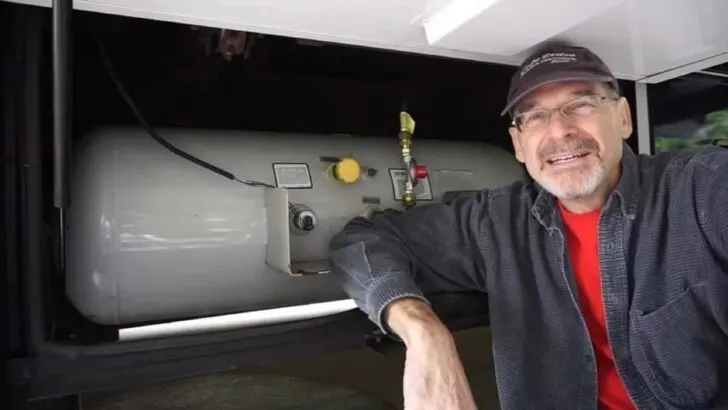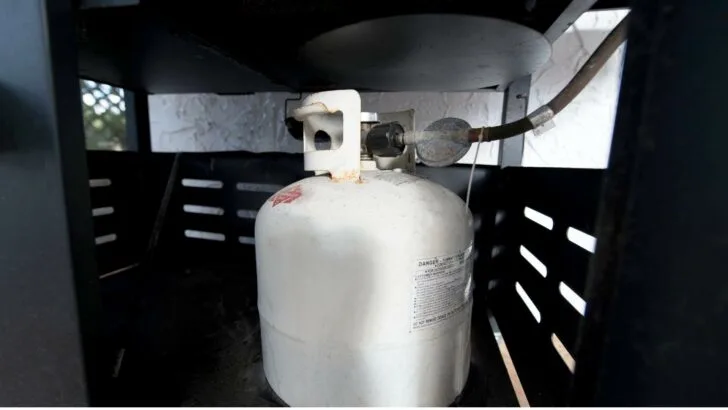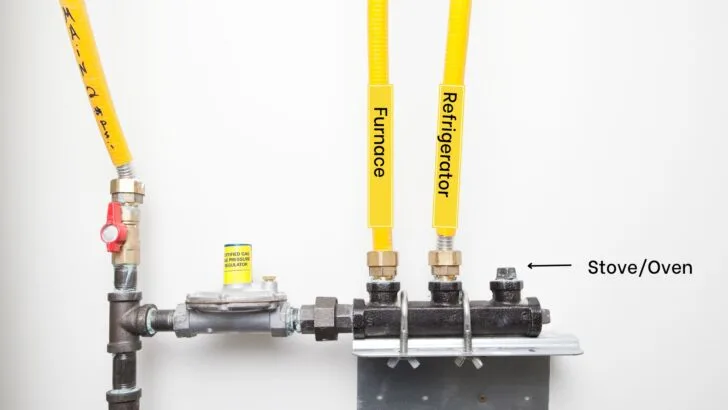Liquid propane (LP gas) is a versatile fuel that powers many of the things that keep you comfortable when you’re RVing. RV propane systems fuel stoves and ovens, water heaters, furnaces, refrigerators (if you have an absorption refrigerator), small propane heaters, and even portable propane fire pits and grills.
Having appliances that run on propane is an incredible gift, especially if you enjoy boondocking (camping off the grid) rather than being tied to crowded campgrounds and RV parks. When you use propane to fuel appliances, you can enjoy camping virtually anywhere, untethered, with all the comforts of home.
But propane needs to be managed responsibly. Not only are propane DOT and ASME tanks under high pressure, but a propane leak anywhere in the system can lead to dangerous carbon monoxide exposure, a fire, or an explosion.
That’s why it’s important to understand how your propane system works – the topic of today’s post. Propane is used safely by thousands upon thousands of RVers every day. Let’s cover some important information to help keep you safe in your RV, too.
How Does an RV Propane System Work?
Let’s answer that question “CliffsNotes” style in a single sentence, and then we’ll break it down to better understand each point in the system.
The way an RV propane system functions, in general, is that propane flows from your RV’s propane tank through a propane regulator, through the propane lines, then to each RV appliance you want to use.
The RV Propane Tank
If you have a motorhome, chances are that you have a built-in ASME propane tank.
ASME tanks are made of heavy steel and are designed for more permanent applications. They may be permanently installed on an RV or outside a home or business.

The design and standards of ASME tanks are governed by the American Society of Mechanical Engineers.
Otherwise, you have a DOT propane tank cylinder or two. These are typically found on smaller campers, travel trailers, truck campers, and 5th wheels. They’re the type of portable tank that you commonly see connected to a home BBQ grill.

DOT propane tanks are designed and governed by the standards of the Department of Transportation.
Note that some travelers carry very small 16 oz portable propane tanks to fuel only a small camp stove or portable heater.
- Lightweight and Portable
No matter what type of propane tank you have, that tank is the first part of your RV propane system.
For lots of specific information related to propane tanks, we encourage you to visit our general post on RV propane tanks as well as our posts that answer the following important questions you may have about RV propane tanks:
We’ve also got a great post and video showing you, step by step, how to make a BBQ grill connection – that is, how to connect a portable BBQ grill (or even to a propane fire pit) to your RV’s onboard propane tank.
And if you want to connect your RV to a large external ASME propane tank where you’ll be stationary for a while, we’ve got you covered with our extensive post on how to set up an RV external propane connection.
The next item in your RV propane system is your propane regulator.
What’s an RV Propane Regulator?
An RV propane regulator is a crucial part of your RV’s propane system. Here’s why:
The LP gas in your propane tank is under very high pressure – typically anywhere from 100 psi to 250 psi. As the name implies, a propane regulator controls, or “regulates”) the propane being released from the tank. Without it, you’d be dealing with a huge, uncontrolled flame, putting you and everyone around you in a very dangerous situation.
So, the propane regulator is actually a critical piece of your RV propane system. It allows the propane to be released in a controlled, consistent manner, at a carefully regulated pressure, as it flows to all of your RV’s onboard appliances.
Can you use your RV’s propane appliances without a propane regulator on the tank? Simple answer: NO!
Many RVs employ a two-stage propane regulator as opposed to a single-stage regulator.
With a two-stage regulator, the first stage lowers the pressure to 10-15 psi, and the second stage brings that down to around an 11-inch water column (another measure of pressure) which is approximately 0.4 psi. This low pressure is just right for your RV’s appliances.
If your RV has a single RV propane tank, it may be equipped with something like this two-stage propane regulator:
- 🏕️Widely Used: Althouth this propane hose with adapter is designed for blackstone griddle 17'' and 22'', when you take off the propane elbow...
- 🏕️Save Your Money: Using this propane adapter hose, you don't need to change the gas tank frequently, you can connect your Blackstone 17'' or...
Many travel trailers have two DOT propane tanks. If your rig has two tanks, it likely has a two-stage changeover regulator that attaches to both tanks.
You’ll turn on both propane tanks and switch the regulator lever to one of the tanks. When the first tank is empty, you’ll switch the lever over to the second tank unless your propane regulator has an automatic changeover feature that will switch to the second tank for you automatically.
Here’s an example of a two-stage propane regulator with an automatic changeover feature:
- Allows removal of the empty cylinder for refill without interrupting propane supply; includes 2 of the 12-inch pigtails to connect the regulator to...
- For RVs with dual propane tanks; it automatically switches from primary to reserve tank when the primary tank is empty
For more detailed information about propane regulators, see our post on RV propane regulators.
Now on to the final stage of your RV’s propane system…
Propane Lines and Manifold
Next, your RV propane system has propane lines that distribute the LP gas to your appliances.
Generally, you’ll have a main line that feeds into a manifold. A separate line runs to each appliance from the manifold which acts as a sort of distribution line.
An RV manifold might look something like this, for example:

An example of a main LP gas line feeding into a manifold from which separate lines feed separate appliances.
As you can see from this example, a manifold is simply a way to control the distribution of LP gas to each of your RV propane appliances. These might include:
- Furnace
- Absorption refrigerator
- Stove/Cooktop
- Oven
- Water heater
With the exception of the cooktop and oven, these appliances are vented to the outside.
Let’s recap briefly before we get to the final part of your RV propane system.
- Liquid propane (LP) is stored in a tank under very high pressure.
- The propane regulator reduces the pressure significantly, to the correct level for RV appliances.
- Propane is delivered to various RV appliances by way of a manifold, and most propane-fueled appliances are vented to the outdoors.
Not sure of the amount of propane left in your tank? Here’s our video demonstrating a neat trick that you’ll love!
Now to the final, and possibly the most important, piece of your RV propane system… the propane detector.






